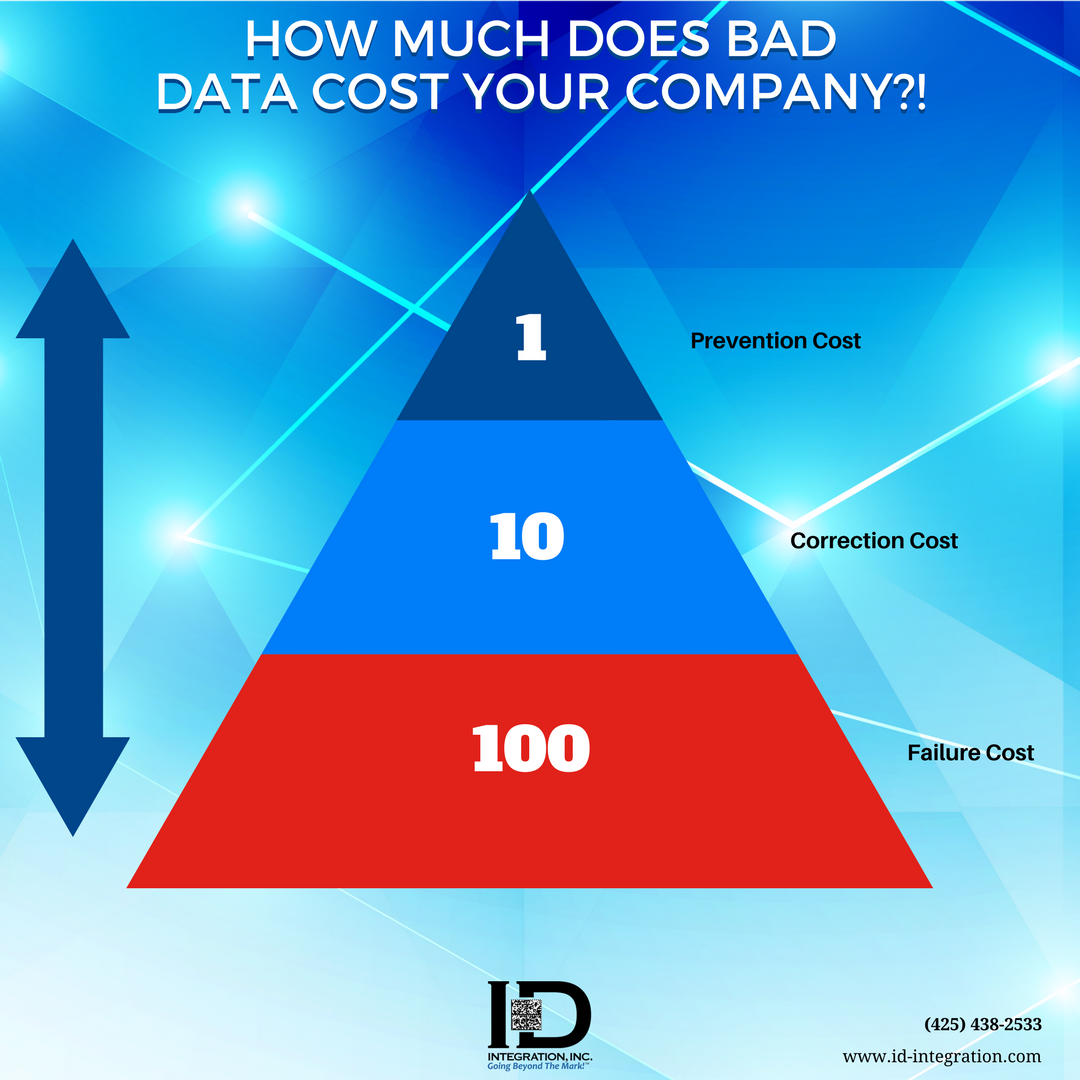Data has a shelf life. When it comes to meeting Department of Defense requirements, IUID marks, nameplates, and labels must be error-free, and they must meet current standards. How is good data a business asset, and how can you ensure that your IUID marking and verification processes are up-to-date? Your systems are only as good as the data that goes into them.
Let’s examine the effects of erroneous IUID marks with the 1-10-100 rule, which was developed in 1992 by George Labovitz and Y Sang Chang to describe efficiency:
-
Level 1: The Cost of Prevention ($1) – Record verification is a low-labor-cost.
Checking IUID marks is a simple task that costs little in labor. Take a barcode scanner/validator and confirm that each mark is good to go, then upload it to the DoD Registry.
-
Level 2: The Cost of Correction ($10) – Discovering bad data and correcting the marks.
When your IUID scanner/validators function properly, you’ll receive a quick notification that a barcode is bad and you can take action to make a correction. Determine the proper nomenclature, and re-mark or re-label the item before submitting it to the DoD Registry. Updating marks is an intermediate step that ensures that the proper Unique Item Identifier (UII) is associated with each part.
-
Level 3: The Cost of Failure ($100) – Assuming records are correct when they are not.
- When your scanner is not capable of validating the Data Matrix syntax to the current MIL-STD-130 and MIL-STD-129R rules
- When the software is corrupted by vicious OS commands embedded within a barcode
- When your systems do not input the IUID info to the Wide Are Workflow (WAWF) properly
- Or your marking machines are behind in maintenance
- You could be operating with the mistaken understanding that your IUID marks will pass DoD IUID requirements
The costs of these failures can be staggering to your business, ranging from the unexpected expenditure of completely overhauling your marking, labeling, and verification systems to the loss of valuable government contracts.
From this model, tackling data quality issues sooner, rather than later, and implementing corrections, saves your company untold costs. As Gary Moe, President and Founder of ID Integration states, “Your systems are only as good at the data that you put into them. If you have people hand-writing information and giving it to others by any manual electronic means, the data won’t be good.”
Here at ID Integration, we offer customized solutions designed to protect your certification, compliance, reputation, and internal costs. Our exclusive BarCodeOS ® enabled scanners are the answer to ensuring that your IUID marks are in line with the present DoD regulations.
Here’s how BarCodeOS enabled scanners prevent the kind of failure described with the 1-10-100 rule:
- BarCodeOS enabled scanners speed up the process of accurately inserting and validating data, because they function as secondary keyboards to your PC. No need to buy and install additional drivers and middleware.
- BarCodeOS enabled scanners power up without the need to install additional configuration software, eliminating the reason for most IT support calls. Configure through your own web portal—Forget about wasting time searching for answers in a 200+ page user manual.
- BarCodeOS enabled scanners sound the alarm when you have a bad IUID mark—One beep and the IUID syntax is good, 4 beeps means it’s bad. This auditory confirmation makes quick work of scanning, because human error is taken out of the equation of validating codes.
- BarCodeOS enabled scanners are the World’s only scanners equipped with a firewall. Your systems are protected from malicious OS commands that can lurk within QR, PDF417, and Data Matrix barcodes.
Learn more facts about IUID compliance. Learn the difference between MIL-130-STD and MIL-STD-129 requirements. Discover the newest MH10.9.17-2017 data matrix encoding guideline. Then watch BarCodeOS technology in action to see how it assists you in your IUID compliance. Don’t let bad data rob you of DoD contracts. Contact our IUID experts at 425-438-2533 to help you navigate the maze of compliance and create a customized plan to update your processes to the newest regulations.

